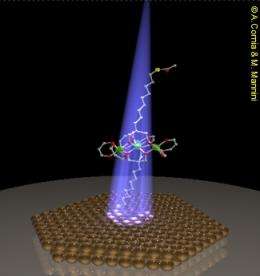The magnetic memory molecule, Fe4, tethered to a gold surface. Image copyright A. Cornia and M. Mannini.
(PhysOrg.com) -- Recent research by scientists in Italy and France shows that that single molecules have the ability to store information via their magnetic state. Their work is a first step toward a new generation of ultra-compact data storage technologies based on individual molecules.
Using x-ray analysis methods, the group learned that iron-containing molecules can display a magnetic "memory" when tethered to a gold surface. This type of finding is a necessary precursor to the ability to store data, bit by bit, on individual molecules rather than capacitors or transistors, which are much larger.
The research is reported in the March 2009 edition of Nature Materials.
"Our work has opened a door to the study of individually magnetized molecules 'wired' to conducting surfaces, which will now allow scientists to investigate the elementary interactions between electron transport and magnetism at the molecular scale," said the paper's corresponding researcher, Roberta Sessoli of the University of Florence, to PhysOrg.com.
Scientists have successfully organized molecules on conducting surfaces, but prior to this work had been unable to determine whether the molecules could retain a specific magnetic property: its ability to "remember" its magnetization history on the molecular level when demagnetized; this is known as magnetic hysteresis. Not only do small molecule clusters tend to be chemically unstable on surfaces, but scientists also lacked the tools to study them.
As they report in their paper, Sessoli and her colleagues proved that synchrotron radiation, the light emitted when charged particles are accelerated to nearly the speed of light around a large conducting ring, is the ideal tool for investigating these materials. Synchrotrons can produce all types of light, from radio waves to gamma-rays.
Using a "self-assembly" method starting with molecules in solution, they deposited a single layer of iron (Fe) molecules—specifically, Fe4, a propeller-shaped molecule—onto a surface of gold.
At two synchrotron facilities, BESSY in Germany and SLS in Switzerland, the group chilled the monolayer of molecules to extremely low temperatures, only a few degrees Kelvin (around -270 degrees Celsius), and placed it in the path of a very concentrated beam of x-ray light produced by the synchrotron. By analyzing how the x-rays interacted with the sample, the group gained specific information about the molecules' magnetic properties despite the tiny amount of molecules present on the surface.
They used x-ray absorption spectroscopy (XAS), in which the x-ray photon energies are tuned to a range in which they can excite core electrons of the selected atomic species, in this case iron. While XAS can probe the electronic state of the deposited molecules, their magnetic properties can be investigated by magnetic circular dichroism (XMCD). It measures how a sample's response to x-ray light that is left circularly polarized (the rays rotate to the left as they propagate forward) is different from light that is right circularly polarized, when the sample is placed in a magnetic field. This method is best at telling researchers about the magnetic properties of the molecules, such as each molecule's "spin," an intrinsic property of a particle, atom, or molecule that imparts it with a very small magnetic field, like a tiny bar magnet.
The researchers compared the XAS and XMCD results. Had the individual magnetic states of the molecules been affected by grafting the molecules to the gold surface, the researcher would have expected to see significant changes in the XAS/XMCD ratio compared to a bulk sample, but observed none.
More information: Nature Materials 8, 194 - 197 (2009)
Copyright 2009 PhysOrg.com.
All rights reserved. This material may not be published, broadcast, rewritten or redistributed in whole or part without the express written permission of PhysOrg.com.






















